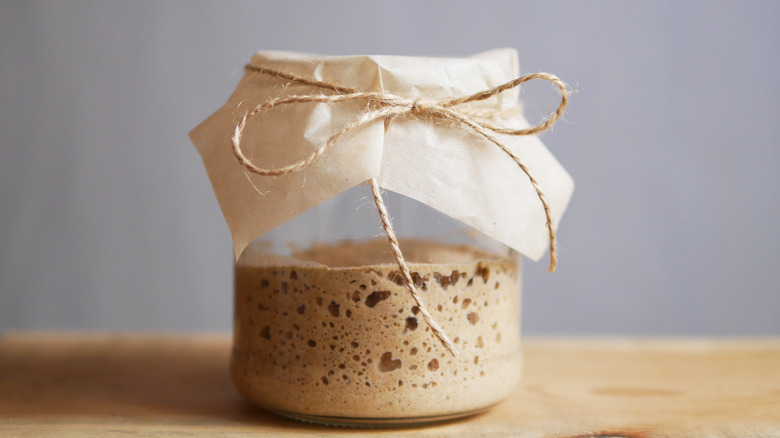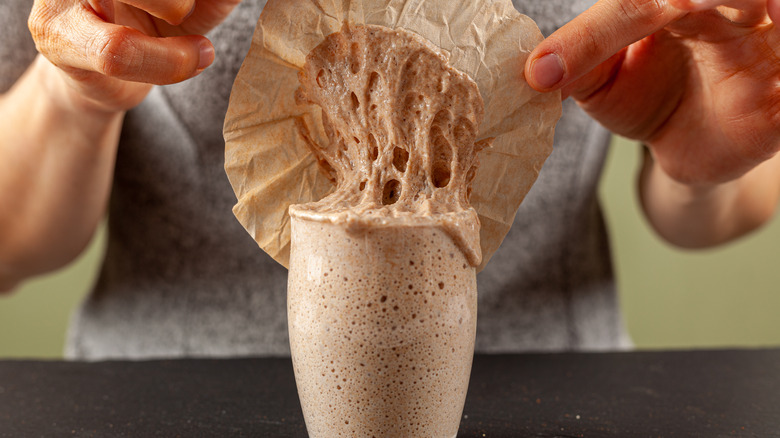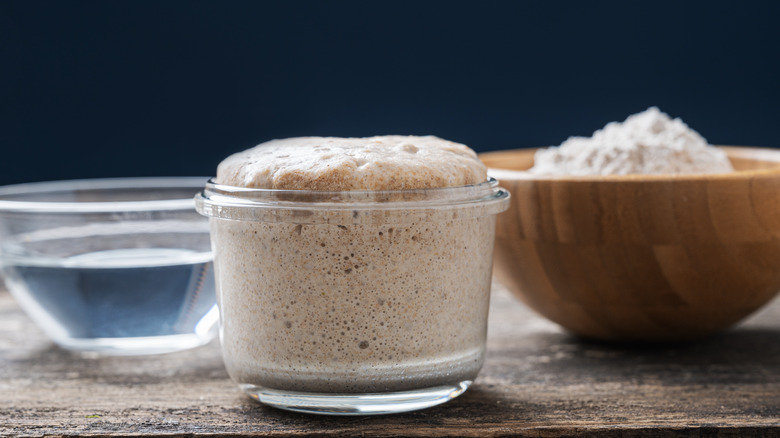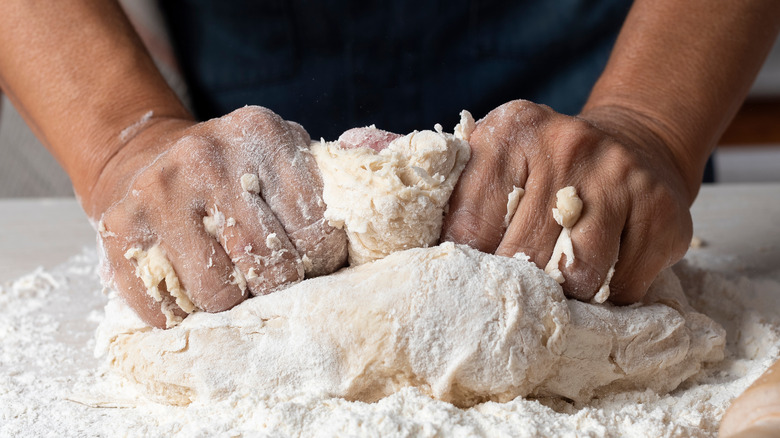Twitter Is In Shambles Over The Age Of A Sourdough Starter
In the U.S. and across the globe, people are obsessed with all things new and trendy and the result is a never-ending flood of media coverage attempting to find the next big thing, according to The New York Times. And yet, we're also keenly fascinated by the oldest objects in our world, especially those that are still alive, like plants, animals, and people. CNN has a whole list, like the world's oldest tortoise living in the South Atlantic at the spry age of 187, or a two-thousand-year-old tree growing in a tiny temple in Sri Lanka.
To find some of the world's oldest organisms living in remote villages or tiny, far away islands is to be expected, but one Twitter user was wrecked after learning of an ancient being living uncomfortably close by – right in their own house. User Elizabeth Handgun tweeted from their account @OneFellSwoop, "Haven't recovered from my roommate telling me her sourdough starter is over 200 years old ... there is an organism from the nineteenth century living in my house with me!!"
Some sourdough starters have seen the rise and fall of nations
In a comment on their tweet, Elizabeth Handgun drove home just how old this starter is. "Has YOUR sourdough starter witnessed the Civil War?? The beginning & end of the Union of Soviet Socialist Republics??? Didn't think so..." A few of Handgun's followers shared her astonishment, with @rachelescochea writing, "My gosh ... you've got yourself a mother dough right there." Others admonished the elderly sourdough starter for not doing more to prevent the two world wars it has lived through, while @mmeJOAN thought the life of a starter might make a good Pixar movie.
What Handgun may not have expected, however, was the number of followers who are also cultivating jars of ancient starters in their fridges. User @insecurecommie claims to have a sourdough starter that was born during the California Gold Rush of 1848, while @gallerychapel shared the story of a starter made from yeast found in a 4,500-year-old Egyptian tomb.
Given this incredible longevity, it seems rather cruel that we reward tenacious sourdough starters with the fate of being baked to death in delicious sourdough breads. But, is it really true: Can sourdough starters live for hundreds of years or longer?
How do sourdough starters get that old?
Sourdough starters rely on microscopic wild yeast that is activated next to bacteria. When combined with flour and liquid, these organisms feed on the sugars in the flour, multiplying and producing carbon dioxide and ethanol. This growth is why sourdough starters become bubbly while doubling or tripling in size. When used in bread baking, the starter makes loaves rise and gives them a tangy flavor that varies from one starter to the next.
Bakers use some of the starter in their baking, but always save a portion in a container to feed with more flour. This new batch feeds and grows, and the cycle repeats itself over and over. This means that, as long as it's regularly replenished, a sourdough starter can be kept alive and handed down for many generations.
As alarmed as Twitter user Elizabeth Handgun was to find the 200-year-old sourdough starter in her fridge, we found an even bigger fridge full of starters. In Brussels, Belgium, the Puratos Center for Bread Flavor houses and feeds sourdough starters from 25 countries. And, it was through the work at this library that a startling discovery was made.
Sourdough starters may even hold traces of past bakers
The curator of Belgium's Puratos sourdough library, Karl De Smedt, carefully maintains all of the starters in the collection, according to The New York Times. Because starters can change when exposed to different yeasts and bacteria of new locations, De Smedt told the outlet that he preserves the original character by feeding them with the ingredients of their source recipes "to minimize the impact of change". Each starter is unique: One from Japan is made using sake rice and another, from Mexico, requires lime juice and beer. While De Smedt can confirm the ingredients of each starter, one thing he cannot verify scientifically is their ages. "We can't carbon-date them," he said. "If someone insisted she had a 500-year-old sourdough, I'd have to believe her."
However, De Smedt did make one discovery about sourdough starters that is truly remarkable. He and a team of biologists from North Carolina State University swabbed the hands of bakers, then analyzed the swabs against samples of each baker's own sourdough starter. They discovered that microbes living on the bakers' skin and in their sourdough starters were the same. "The bakers' hands reflect the life they have lived," said biologist Dr. Rob Dunn, "a life with their fingers and thumbs in dough."
So, when sourdough starters are handed down from one generation to the next, not only do they carry incredible history, they may actually carry tiny, living traces of the ancestors who cared for them.



